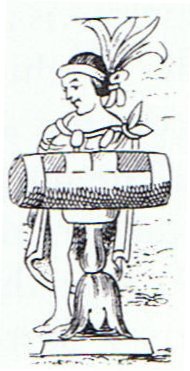Bb12.2
When in November 3 (*227 → π)
... About Carmenta we know from the historian
Dionysus Periergetis that she gave orcales to Hercules and lived
to the age of 110 years. 110 was a canonical number, the ideal
age which every Egyptian wished to reach and the age at which,
for example, the patriarch Joseph died. The 110 years were made
up of twenty-two Etruscan lustra of five years each; and
110 years composed the 'cycle' taken over from the Etruscans by
the Romans. At the end of each cycle they corrected
irregularities in the solar calendar by intercalation and held
Secular Games. The secret sense of 22 - sacred numbers were
never chosen haphazardly - is that it is the measure of the
circumference of the circle when the diameter is 7. This
proportion, now known as pi, is no longer a religious
secret; and is used today only as a rule-of-thumb formula, the
real mathematical value of pi being a decimal figure
which nobody has yet been able work out because it goes on
without ever ending, as 22 / 7 does, in a neat recurring
sequence [3.142857142857 ...]. Seven lustra add up to
thirty-five years, and thirty-five at Rome was the age at which
a man was held to reach his prime and might be elected Consul.
(The same age was fixed upon by a Classically-minded Convention
as the earliest at which an American might be elected President
of the United States.) ...
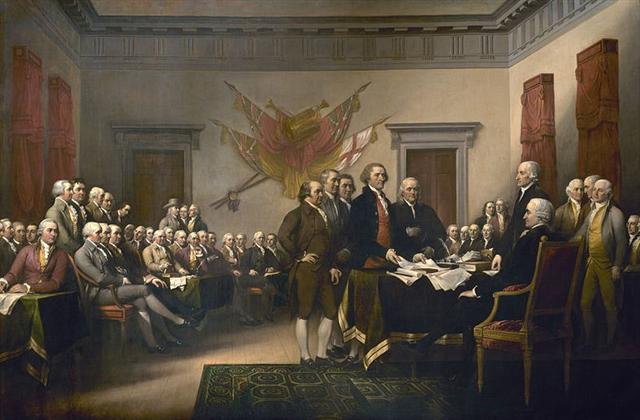
the right ascension line connected with the Nose of the Sea
Beast (Menkar, α Ceti) could be (ideally) observed close to the
Full Moon it was known to indicate MARCH 1 (60) as extrapolated
back in precessional time-space from my assumed era for
rongorongo down to the Golden Age of the Bull:

 |
 |
 |
 |
| Bb12-1
(427 + 35) |
Bb12-2
(463) |
Bb12-3 |
Bb12-4 (465) |
| Nov
3 |
4 |
5 |
6 (310) |
|
ω Bootis
(227.2),
NEKKAR (Herdsman) = β Bootis
(227.3), σ Librae (227.5), π² Oct. (227.7),
NADLAT
(Mean Little Ones) = ψ Bootis
(227.8), π Lupi (227.9)
*227
- *35 = *192 (MIMOSA) |
15h
(228.3)
ZUBEN
HAKRABIM (Claw of the Scorpion) = ν Librae
(228.3), λ Lupi (228.9) |
ω
Oct. (229.3),
ι
Librae (229.6),
κ
Lupi (229.7),
ζ
Lupi (229.8) |
Al Zubānā-14b (Claws)
χ
Bootis (230.3),
PRINCEPS =
δ
Bootis
(230.6),
ZUBEN ELSCHEMALI (Northern Claw) =
β
Librae
(230.8) |
| May 4 |
5
(125) |
6 |
7
(127 = 310 - 183) |
|
'April 7 |
8 |
9 |
10
(100) |
|
"March
24 |
25 (Julian equinox) |
26
(*5) |
27 (86 = 127 - 41) |
|
MARCH 1 |
2
(61 = 125 - 64) |
3 |
4 |
|
MENKAR (The Nose) =
α
Ceti
(44.7)
*44
- *35 = *9 (DENEB KAITOS) |
3h
(45.7)
GORGONEA TERTIA =
ρ
Persei
(45.1),
ALGOL (The Demon) =
β
Persei
(45.9) |
ι
Persei (46.1),
MISAM (Next to the Pleiades) =
κ
Persei
(46.2),
GORGONEA QUARTA =
ω
Persei
(46.7),
BOTEIN (Pair of Bellies) =
δ
Arietis
(46.9) |
ζ
Arietis (47.7) |
|
eaha te ika hiku raverave |
e tagata hakapuo - i te
haú |
i ruga i te ragi |
eaha te manu itiiti |
|
Hiku. Tail; caudal fin. Hikukio'e, 'rat's
tail': a plant (Cyperus vegetus). Vanaga.

... In China, with Capricornus,
Pisces, and a part of Sagittarius, it [Aquarius] constituted the early
Serpent, or Turtle, Tien Yuen; and later was known as Hiuen
Ying, the Dark Warrior and Hero, or Darkly Flourishing One, the
Hiuen Wu, or Hiuen Heaou, of the Han dynasty, which
Dupuis gave as Hiven Mao. It was a symbol of the emperor
Tchoun Hin, in whose reign was a great deluge; but after the Jesuits
came in it became Paou Ping, the Precious Vase. It contained
three of the sieu, and headed the list of zodiac signs as the Rat,
which in the far East was the ideograph for 'water', and still so
remains in the almanacs of Central Asia, Cochin China, and Japan
...
...
In the deep night before the image [of Lono]
is first seen, there is a Makahiki ceremony called
'splashing-water' (hi'uwai). Kepelino tells of sacred chiefs
being carried to the water where the people in their finery are bathing;
in the excitement created by the beauty of their attire, 'one person was
attracted to another, and the result', says this convert to Catholicism,
'was by no means good' ...
 |
*20 |
 |
*16 |
 |
|
Bb11-9 (427) |
Bb11-29 |
Bb12-2
(463 = 427 + 36) |
|
MIMOSA (*192) |
THUBAN (*212) |
ZUBEN HAKRABIM (*228) |
|
DENEB KAITOS (*9) |
ALRISHA (*29) |
ALGOL (*45
= *9 + *36) |
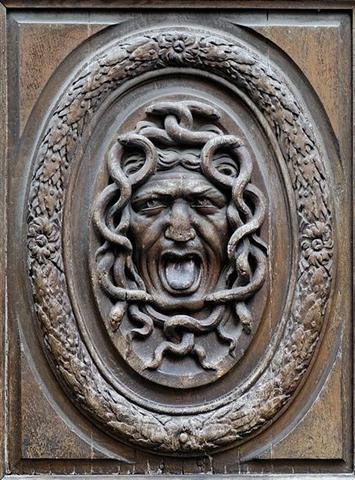
...
In the sky, Perseus lies next to his
beloved Andromeda. Nearby are her
parents Cepheus and Cassiopeia, as well
as the monster, Cetus, to which she was
sacrificed. Pegasus the winged horse
completes the tableau. Perseus himself
is shown holding the Gorgon’s head. The
star that Ptolemy called ‘the bright one
in the Gorgon head’ is Beta Persei,
named Algol from the Arabic
ra’s al-ghul
meaning ‘the demon’s head’. (As an
aside,
al-ghul is
also the origin of our word alcohol -
quite literally ‘the demon drink’.)
Algol is the type of star known as
an eclipsing binary, consisting of two
close stars that orbit each other, in
this case every 2.9 days ...
|
The comment of Metoro when referring to the
Rogo (Lono) figure - e tagata hakapuo -
could mean that in November 4 (308 = 244 + 64 =
61 + 183 + 64) the Full Moon
would (ideally) be at the right ascension line
for the demon star (Algol) who blocked the
entrance and exit holes for the Sun.
... Antares, visible in the morning sky of December-January,
came to stand for summer heat; hence the saying, 'Rehua cooks (ripens)
all fruit'. The generally accepted version of the Rehua myth, according
to Best, is that Rehua had two wives, the stars on either side of
Antares. One was Ruhi-te-rangi or Pekehawani, the personification
of summer languor (ruhi), the other Whaka-onge-kai,
She-who-makes-food-scarce before the new crops can be harvested ...
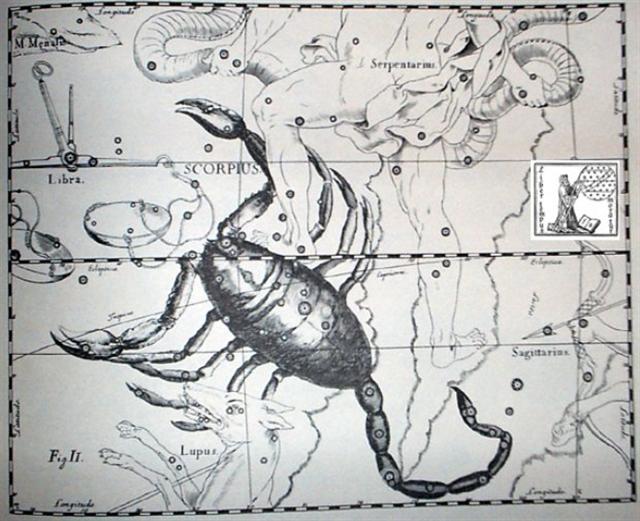
Haka-puo
→ Making a cover
→ over the 'holes' (pu)
for the Sun.
In view of the obvious importance of Algol /
Zuben Hakrabim a few more
strange details ought to be mentioned here:
... The myth is that Perseus was sent to cut off the head of
the snaky-locked Gorgon Medusa, a rival of the Goddess Athene, whose baleful
look turned men into stone, and that he could not accomplish the task until he
had gone to the three Graeae, 'Grey Ones', the three old sisters of the Gorgons
who had only one eye and one tooth between them, and by stealing eye and tooth
had blackmailed them into telling him where the grove of the Three Nymphs was to
be found. From the
Three Nymphs he then obtained winged sandals like those of Hermes, a bag to put
the Gorgon's head into, and a helmet of invisibility. Hermes also kindly gave
him a sickle; and Athene gave him a mirror and showed him a picture of Medusa so
that he would recognize her. He threw the tooth of the Three Grey Ones, and some
say the eye also, into Lake Triton, to
break their power, and flew on to Tartessus where the Gorgons lived in a grove
on the borders of the ocean; there he cut off the sleeping Medusa's head with
the sickle, first looking into the mirror so that the petrifying charm should be
broken, thrust the head into his bag, and flew home pursued by other Gorgons ...

5 days after Algol was Algenib Persei
and 10 days after Algol were the
6 Stars (Tau-ono):
 |
 |
 |
|
Bb12-5 (421 + 466) |
Bb12-6 (888) |
Bb12-7 |
|
Nov 7 (311) |
8 |
9 |
|
μ
Lupi,
γ
Tr. Austr.
(231.3), ο Librae (231.8) |
ο
Cor. Borealis (232.0),
δ
Lupi (232.1),
φ¹,
ν²
Lupi (232.2),
ν¹
Lupi (232.3),
ε
Lupi (232.4),
φ²
Lupi (232.5),
PHERKAD (The Dim One of the Two Calves) =
γ
Ursae Min.
(232.6),
ε
Librae (232.7),
η
Cor. Borealis (232.8),
υ
Lupi (232.9)
*191.0 = *232.4 - 41.4 |
ALKALUROPS (The Herdsman's Lance) =
μ
Bootis
(233.1),
ED ASICH (Male Hyena) =
ι
Draconis
(233.2) |
|
ZIBAL (Young Ostriches) =
ζ Eridani (48.0),
κ
Ceti (48.9) |
τ Arietis (49.7) |
ALGENIB PERSEI = α Persei (50.0), ο Tauri (50.2), ξ Tauri (50.8)
GIENAH (γ Corvi) |
|
May 8 (128) |
9 |
10 |
|
'April 11 (101) |
12 |
13 |
|
ui ki te
mata mai tae e haga hia |
ka tupu
te kihikihi |
ma to ihe |
|
Kihikihi, lichen; also: grey,
greenish grey, ashen. Vanaga. Kihikihi,
lichen T, stone T. Churchill. The
Hawaiian day was divided in three general parts,
like that of the early Greeks and Latins, - morning,
noon, and afternoon - Kakahi-aka, breaking
the shadows, scil. of night; Awakea,
for Ao-akea, the plain full day; and
Auina-la, the decline of the day.
The lapse of the night, however,
was noted by five stations, if I may say so, and
four intervals of time, viz.: (1.) Kihi, at 6
P.M., or about sunset; (2.) Pili, between
sunset and midnight; (3) Kau, indicating
midnight; (4.) Pilipuka, between midnight and
surise, or about 3 A.M.; (5.) Kihipuka,
corresponding to sunrise, or about 6 A.M. ...
(Fornander)
 |
 |
 |
 |
 |
 |
|
Bb12-8 |
Bb12-9 |
Bb12-10 |
Bb12-11 |
Bb12-12 (473) |
|
Nov 10 (314 → π) |
11 |
12 |
13 |
14 |
|
NUSAKAN (Pauper's Bowl) = β Cor. Bor.
(234.0), κ¹ Apodis (234.3), ν Bootis (234.7), ζ
Librae (234.9) |
θ Cor. Borealis (235.3), γ Lupi (235.6),
GEMMA =
α Cor. Bor.,
ZUBEN ELAKRAB = γ Librae, QIN = δ Serpentis, ε Tr.
Austr. (235.7), μ Cor. Borealis (235.8), υ Librae (235.9)
SIRRAH (α Andromedae) |
φ Bootis (236.2), ω Lupi, τ Librae (236.3), ψ¹ Lupi
(236.7), ζ Cor. Borealis (236.9) |
.
κ
Librae (237.2),
ι
Serpentis (237.4),
ψ²
Lupi,
ρ
Oct.
(237.5), γ Cor. Borealis, η Librae (237.7), COR
SERPENTIS = α Serpentis
(237.9)
*196.0 = *237.4 - *41.4 |
π
Cor. Borealis,
UNUK ELHAIA (Necks of the Serpents) =
λ
Serpentis
(238.1),
CHOW =
β
Serpentis
(238.6) |
|
... In other words, the ancient Druidic religion
based on the oak-cult will be swept away by
Christianity and the door - the god Llyr - will
languish forgotten in the Castle of Arianrhod, the
Corona Borealis. This helps us to understand
the relationship at Rome of Janus and the White
Goddess Cardea who is ... the Goddess of Hinges who
came to Rome from Alba Longa. She was the hinge on
which the year swung - the ancient Latin, not the
Etruscan year - and her importance as such is
recorded in the Latin adjective cardinalis -
as we say in English 'of cardinal importance - which
was also applied to the four main winds; for winds
were considered as under the sole direction of the
Great Goddess until Classical times ... |
|
σ Persei (51.6) |
No star listed (52) |
ψ
Persei (53.1)
ACRUX (α
CRUCIS) |
δ
Persei (54.7) |
Al Thurayya-27 (Many Little
Ones) /
Krittikā-3
(Nurses of Kārttikeya)
/
TAU-ONO (Six Stones)
ATIKS =
ο
Persei, RANA (Frog) =
δ
Eridani
(55.1),
CELAENO (16 Tauri), ELECTRA (17), TAYGETA (19),
ν
Persei (55.3), MAIA (20), ASTEROPE (21), MEROPE (23)
(55.6)
|
 |
|
May 11 |
12 (132) |
13 |
14 |
15 (365 + 135 =
500) |
|
'April 14 (104) |
15 |
16 (*26) |
17 (107) |
18 (108) |
|
e tagata
rima piri ki te puoko |
ko te
maitaki |
i haga
opua hia |
ko te
tagata kua oho - ki haga o rave
hía |
mai tae
rutu hia i te pahu -
mai tae oho te rima |
|
Rutu.
1. To read, to recite, to pronounce words solemnly;
he-rutu i te kohau motu, to read the
rongorongo tablets; hare rutu rogorogo mo
hakama'a ki te ga poki ite kai, i te rogorogo,
rongorongo school, house in which children were
taught reading and writing the rongorongo signs. 2.
To pelt with stones. 3. To gather in great numbers
(of people). Vanaga. Sound. Rutu-rongorongo =
the sound of recitation. Barthel. T. Beat. Henry. To
recite; tae rutu, irreverence.
Churchill.Pau.: rutu, a drum. Mgv.: rutu,
to beat, to cause to resound. Ta.: rutu, a
drum, to drum. Mq.: utu, to drum. Sa.:
lutu, to shake a rattle.
Churchill.
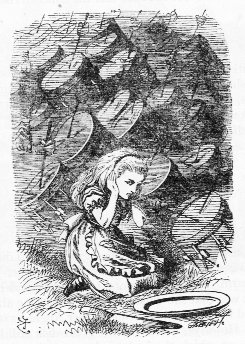
... rutua - te pahu - rutua te
maeva - atua rerorero - atua hiko ura - hiko o tea -
ka higa te ao ko te henua ra ma te hoi atua ...
(Cb1)
Pahu. Drum. Pahu-rutu-roa =
Long-beating-drum. Barthel. M. Pahū.
Tree gong. Starzecka.
Pahu uma,
coffin; in modern usage, any sort of jar.
Pahupahu = To dig a hole. Vanaga. A trough,
barrel, cask, cradle, drum, chest, box;
pahu nui, a
kettle; pahu oka,
a drawer; pahu
papaku, coffin;
pahu rikiriki,
sheath; pahu
viriviri, hogshead.
Pahupahu,
box. Churchill. A trough, barrel, cask, cradle,
drum, chest, box;
pahu nui, a kettle;
pahu oka,
a drawer; pahu
papaku, coffin;
pahu rikiriki,
sheath; pahu
viriviri, hogshead;
pahupahu,
box. P Mgv., Ta.:
pahu, a drum. Mq.:
pahu, a
drum, a large cylindrical container. (To.:
bahu, a
hollow tree set in water as a filter.) Sa.:
pusa, a
box. To.: buha,
id. Fu.: pusa,
id. Niue: puha,
id. Pau.: puha,
id. Pahuahi,
lantern, beacon.
Paukumi, closet, cupboard.
Pahupopo,
a mould; pahupopokai,
cupboard for food.
Pahure: 1. To sweep everything away. 2.
To wound, to lacerate, scar, bruise, lesion, sore;
pahurehure,
to wound, to scratch;
hakapahure, to wound. T Pau.:
pahure,
to be skinned;
pahore, to peel off, to scale. Mgv.:
pahore,
to cut off, to chop, to slice. Ta.:
pahore,
to flay, to skin. Churchill 2. |
At this place I dare not continue any further down in precessional space-time
all the way to
the Golden Age of the Bull because MARCH 2 was when (ideally) the Full Moon
would have been at Algol.
... The leap day was introduced as part of the Julian reform.
The day following the Terminalia (February 23) was doubled,
forming the 'bis sextum - literally 'double sixth', since
February 24 was 'the sixth day before the Kalends of March'
using Roman inclusive counting (March 1 was the 'first day') ...
|






































